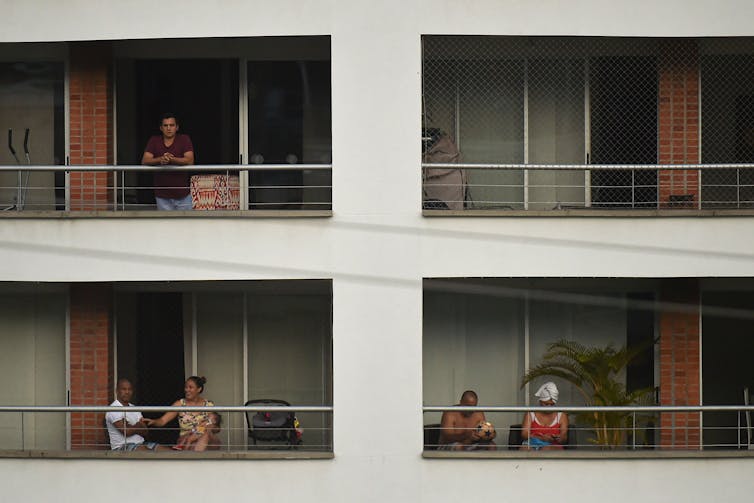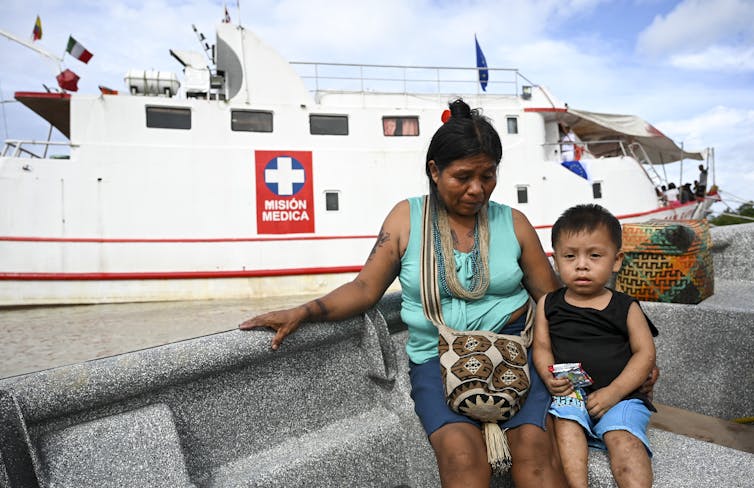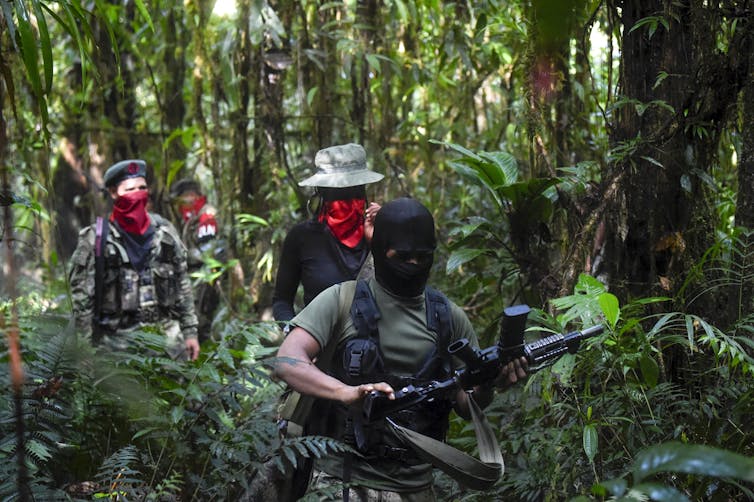Colombia hopes for 'humanitarian' ceasefire during coronavirus as violence resurges
- Written by Shauna N Gillooly, PhD Candidate, Political Science, University of California, Irvine
Colombia’s 2016 peace accord[1] was meant to end a half century of conflict with the Marxist Revolutionary Armed Forces of Colombia, or FARC.
Yet some areas previously dominated by the FARC guerrillas are seeing unintended consequences[2] of that agreement, including a turf war between other armed groups. Colombian paramilitaries, drug traffickers and rebel groups[3] are now fighting for control over what was once FARC territory.
One result of renewed violence in Colombia is that humanitarian aid groups are less able to reach conflict-affected communities that have long depended on their services, according to my research[4] on the Colombian peace process.
Such international assistance is more critical than ever as coronavirus spreads across the South American country[5].
 People in the city of Cali on their balconies during Colombia’s national coronavirus lockdown, April 6, 2020.
LUIS ROBAYO/AFP via Getty Images[6]
People in the city of Cali on their balconies during Colombia’s national coronavirus lockdown, April 6, 2020.
LUIS ROBAYO/AFP via Getty Images[6]
Unintended consequences of ‘peace’
Colombia’s 2016 peace deal[7] with the FARC was far-reaching. To meet the guerrillas’ demands, the government promised land reform, economic development and political inclusion of the rural areas controlled by the FARC.
Three years later, implementation of these ambitious agreements remains slow, underfunded and incomplete[8]. Repeating a situation documented in other post-conflict zones[9], the government’s lack of presence and control in previously FARC-dominated regions has left a power vacuum for other armed groups to contest the territory.
Violence is particularly high in Colombia’s Pacific coast area, which is predominantly black and indigenous[10], and is among Colombia’s most socially and economically marginalized[11] regions. But it is rich in resources like gold and coca[12], the traditional Andean crop used to make cocaine – both lucrative income sources which help fund the illegal activities of armed groups.
Poverty rates reach 59% in some areas of the Colombian Pacific, compared to a 27% national average[13]. The most recent census shows that up to 70% of people in parts the Pacific have insufficient access to potable water, food and housing[14].
As a result, many households, businesses, farms and community projects in Colombia’s Pacific region rely on humanitarian assistance and development aid.
This year Colombia is slated to receive US$448 million in total aid from United States[15]. The European Union[16] and Catholic Church[17] also provide substantial humanitarian aid to the country.
But the recent proliferation of criminal groups[18] is making it very difficult for humanitarian groups to do their work.
 Colombians from the Wounaan indigenous group before a medical checkup on the European Union-supported hospital ship ‘San Raffaele,’ Choco department, Colombia, April 24, 2019.
RAUL ARBOLEDA/AFP via Getty Images[19]
Colombians from the Wounaan indigenous group before a medical checkup on the European Union-supported hospital ship ‘San Raffaele,’ Choco department, Colombia, April 24, 2019.
RAUL ARBOLEDA/AFP via Getty Images[19]
‘We don’t know who’s in charge’
Before the 2016 peace deal, “we knew who to negotiate with,” a representative of an aid group based in the city of Cali, told me.
The aid worker, who like all participants in my research must remain anonymous for safety and ethics reasons, said his staff used to negotiate with the local FARC or paramilitary bloc commander to ensure safe passage for their aid supplies.
“Now we can’t do that,” he said, “because we don’t know who’s in charge.”
There was a brief honeymoon period of reduced violence[20] following the 2016 peace accord, an aid worker from a different humanitarian group told me. Now, he said, while aid is still getting to some high-need urban communities in Colombia’s Pacific region, remote areas are increasingly hard to access.
 Members of the National Liberation Army (ELN) guerrillas, during a training in El Choco, Colombia, May 26, 2019.
RAUL ARBOLEDA/AFP via Getty Images[21]
Members of the National Liberation Army (ELN) guerrillas, during a training in El Choco, Colombia, May 26, 2019.
RAUL ARBOLEDA/AFP via Getty Images[21]
“Armed groups often check the cars or boats that pass through their territory,” he said. “So, if you have aid materials with you, it can be complicated, depending on who’s in charge that day.”
Sometimes, he told me, their deliveries of supplies like textbooks, medical supplies, seeds and fertilizer are let through without problem. Other times, local paramilitaries or rebel groups seize the supplies and threaten the humanitarian workers.
COVID-19 and human rights
Violence is also complicating Colombia’s response to the global coronavirus pandemic.
Colombia, which passed the 1,000 COVID-19 case mark[22] in early April, has been proactive in its efforts to contain the virus. The country is under a nationally mandated quarantine until at least April 13.
 Colombian soldiers deliver food to low-income residents under lockdown in the city of Cali, March 26, 2020.
LUIS ROBAYO/AFP via Getty Images[23]
Colombian soldiers deliver food to low-income residents under lockdown in the city of Cali, March 26, 2020.
LUIS ROBAYO/AFP via Getty Images[23]
That hasn’t kept Colombia’s armed groups at home. As the country prepared for quarantine the week of March 23, three community leaders[24] were killed. The murders are part of a wave of violence against Colombian community organizers who have led protests and strikes by indigenous and peasant communities to demand[25] the social and economic justice initiatives promised in the peace deal.
An estimated 600 to 900 activists[26] have been murdered in Colombia since 2016.
An uncertain future for peace
Following the United Nations’ appeal on March 24 for a global ceasefire while the coronavirus crisis lasts, the ELN – Colombia’s largest active guerrilla group – declared a monthlong ceasefire[27] as a “humanitarian gesture.” So far, other armed groups have not heeded the call[28].
Humanitarian workers worry that aid to the country may start to dry up[29] with supplies from the U.S. and Europe being redirected to their domestic coronavirus response.
“As different countries around the world close their borders and brace themselves for COVID-19, we expect to see a huge decrease in the level of international aid we’ll receive,” a Colombian government member who works in international cooperation and humanitarian projects told me.
In the meantime, the violence indirectly caused by the 2016 peace accords continues in Colombia, complicated by the arrival of COVID-19.
[You need to understand the coronavirus pandemic, and we can help. Read The Conversation’s newsletter[30].]
References
- ^ 2016 peace accord (www.bbc.com)
- ^ unintended consequences (www.foreignaffairs.com)
- ^ paramilitaries, drug traffickers and rebel groups (www.crisisgroup.org)
- ^ my research (www.shaunangillooly.com)
- ^ across the South American country (www.reuters.com)
- ^ LUIS ROBAYO/AFP via Getty Images (www.gettyimages.com)
- ^ Colombia’s 2016 peace deal (theconversation.com)
- ^ slow, underfunded and incomplete (theconversation.com)
- ^ documented in other post-conflict zones (www.cambridge.org)
- ^ predominantly black and indigenous (propacifico.org)
- ^ Colombia’s most socially and economically marginalized (colombiareports.com)
- ^ rich in resources like gold and coca (revistas.uniandes.edu.co)
- ^ compared to a 27% national average (www.crisisgroup.org)
- ^ insufficient access to potable water, food and housing (www.dane.gov.co)
- ^ is slated to receive US$448 million in total aid from United States (colombiareports.com)
- ^ European Union (ec.europa.eu)
- ^ Catholic Church (www.pasocial.org)
- ^ proliferation of criminal groups (colombiareports.com)
- ^ RAUL ARBOLEDA/AFP via Getty Images (www.gettyimages.com)
- ^ brief honeymoon period of reduced violence (www.pbs.org)
- ^ RAUL ARBOLEDA/AFP via Getty Images (www.gettyimages.com)
- ^ passed the 1,000 COVID-19 case mark (colombia.as.com)
- ^ LUIS ROBAYO/AFP via Getty Images (www.gettyimages.com)
- ^ three community leaders (www.theguardian.com)
- ^ led protests and strikes by indigenous and peasant communities to demand (thebogotapost.com)
- ^ 600 to 900 activists (colombiapeace.org)
- ^ ceasefire (www.bbc.com)
- ^ heeded the call (colombiapeace.org)
- ^ may start to dry up (northafricapost.com)
- ^ Read The Conversation’s newsletter (theconversation.com)
Authors: Shauna N Gillooly, PhD Candidate, Political Science, University of California, Irvine

